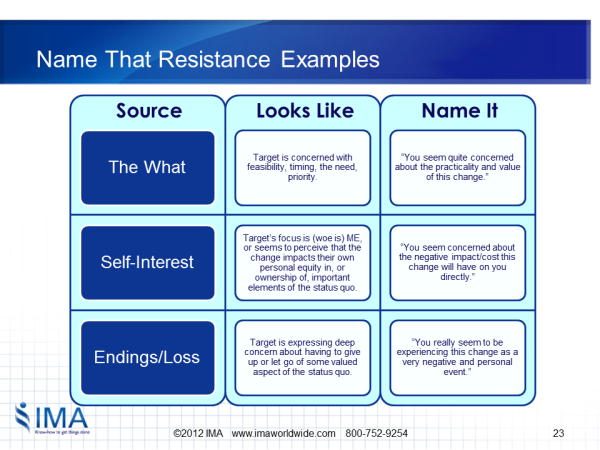While a practical change management methodology like the Accelerating Implementation Methodology (AIM) can be useful in managing resistance to change, no methodology will eliminate resistance. 
Resistance to change is inevitable, and it is not logical (remember that resistance is a function of the degree of disruption the change represents, from the Frame of Reference of the Targets.) So you will never communicate your way out of resistance or get adoption of changes by presenting arguments explaining the rationale of your change, especially from the 1,000 foot corporate level.
Overt vs. Covert Resistance
In fact, managing resistance to change is even more challenging because when it comes to resistance, things "may not be what they seem." This means that what you see on the surface can be different from what is really going on. Here are some examples:
|
Observable Resistance to Change |
What is Really Going On |
|
Overt (I express my resistance) |
Covert (It looks like I am changing but I am really not) |
|
Ability (I lack the skills to make the change) |
Willingness (I’m not motivated, so training won’t make it better) |
|
Action (I’m busy changing) |
Inaction (If I just wait, this too will pass) |
|
Conscious (My actions demonstrate my resistance) |
Unconscious (I don’t realize I’m being resistant) |
Change Agents must have the skills and knowledge to deal with both observable resistance to change, and the underlying real resistance.
Because the AIM change management methodology is tactical, we have specific tactics that can be applied by managers in dealing with both overt and covert resistance to change. One of the primary tactics we recommend for Change Agents is to "go to the resistance early" because understanding the source of the resistance provides invaluable learning that can be used to build readiness for the change.
One of the biggest mistakes that Change Agents (and this includes managers who are both Reinforcing Sponsors who are also Change Agents) make is that they simply talk too much in their efforts to convince the Targets of the logic of the change. Change Agents should actually only take up 25% of the "air time" in their discussions with Targets! Change Agents will be far more effective if they listen more, and talk less.
Identify the Real Source of Resistance to Change
Listening will help Change Agents uncover the real source of the resistance to change. Once you better understand the source of the resistance, Change Agents should "name that resistance" with recommended responses. The source of the change may be the content of the change, the process and methods, or the endings/losses the Target is experiencing:

Other sources of resistance can include disruptions to understanding and trust or habits. Sometimes the source of the resistance looks like it is about the current change but really is about "old stuff." This is why a principle of the AIM Change Management Methodology is that no change occurs in isolation, it occurs in the climate of the current change and the context of all previous changes."
What's more, this explains why the adoption of change not only impacts the current change but your next changes, too!
Another example of things not being what they seem are what we call "red herrings." These red herrings can throw off an inexperienced Change Agent who only pays attention to what is going on at the surface. Examples of red herrings include a Target (or collective Targets) who floods you with details, offersone word answers, changes the subject, appears to be in total compliance, attacks you, or goes silent. Each of these red herrings requires a different tactical response.
So managing resistance to change is an important element of a change management methodology, but don't simply rely on your communications plan to make this happen. Pay attention to what you see on the surface-- what's observable and overt-- and what is going on below the surface-- the covert resistance that masquerades as something else.


